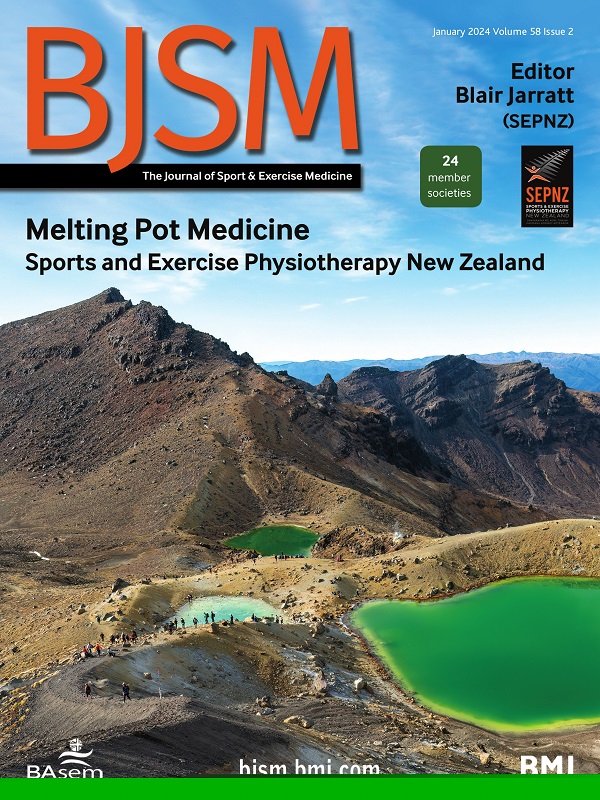NICE Standard for low back pain and sciatica needs urgent revision
IF 11.6
1区 医学
Q1 SPORT SCIENCES
引用次数: 0
Abstract
Low back pain is the leading cause of years lived with disability, imposing an enormous economic burden on society. In the UK, the cost of treating low back pain in general practice alone was estimated to be £3.2 billion in 2015, with 80% of these costs attributed to healthcare consultations.1 The healthcare costs of low back pain and neck pain were estimated to be US$134.5 billion in the USA in 2016.2 In 2016, the National Institute for Health and Care Excellence (NICE) released a guideline containing evidence-based recommendations for the management of low back pain and sciatica.3 Subsequently, NICE published the Clinical Care Standard in 2017 focusing on priority areas for healthcare quality improvement for the management of low back pain and sciatica.4 The NICE Standard is composed of a set of ‘quality statements’ describing the high quality care that should be provided and ‘quality measures’ to assess the care specified in the statement.5 Our view, however, is that health service planners, clinicians and patients are not well served by the 2017 NICE Standard.4 In this viewpoint, we discuss the problems with the 2017 NICE Standard and suggest how the Standard could be revised so that it better reflects the current evidence and provides more helpful guidance for clinicians. The evidence of the effectiveness of the interventions discussed in this viewpoint is provided in online supplemental file 1. ### Supplementary data [bjsports-2025-109817supp001.pdf] The recommendations in the 2017 NICE Standard are underpinned by the 2016 NICE guideline for the management of low back pain and sciatica.3 4 As the NICE guideline was issued nearly 10 years ago, some of the recommendations and, consequently, the NICE Standard are not in line with the most recent evidence. Three interventions that are recommended in the Standard (risk stratification, self-management and radiofrequency denervation) …NICE关于腰痛和坐骨神经痛的标准急需修订
腰痛是多年残疾的主要原因,给社会带来了巨大的经济负担。在英国,2015年治疗腰痛的费用估计为32亿英镑,其中80%的费用归因于医疗咨询2016年,美国腰痛和颈部疼痛的医疗成本估计为1345亿美元。2016年,美国国家健康与护理卓越研究所(NICE)发布了一份指南,其中包含了治疗腰痛和坐骨神经痛的循证建议随后,NICE于2017年发布了临床护理标准,重点关注下背部疼痛和坐骨神经痛管理医疗质量改善的优先领域NICE标准由一组描述应提供的高质量护理的“质量声明”和评估声明中规定的护理的“质量措施”组成然而,我们的观点是,2017年NICE标准并没有很好地服务于卫生服务规划者、临床医生和患者。4在这个观点下,我们讨论了2017年NICE标准存在的问题,并建议如何修改标准,使其更好地反映当前的证据,并为临床医生提供更有用的指导。这一观点所讨论的干预措施有效性的证据在在线补充文件1中提供。[bjsports-2025-109817supp001.pdf] 2017年NICE标准中的建议以2016年NICE腰痛和坐骨神经痛管理指南为基础。由于NICE指南是近10年前发布的,因此一些建议以及NICE标准与最新的证据不一致。标准中推荐的三种干预措施(风险分层、自我管理和射频抑制)……
本文章由计算机程序翻译,如有差异,请以英文原文为准。
求助全文
约1分钟内获得全文
求助全文
来源期刊
CiteScore
27.10
自引率
4.90%
发文量
217
审稿时长
3-8 weeks
期刊介绍:
The British Journal of Sports Medicine (BJSM) is a dynamic platform that presents groundbreaking research, thought-provoking reviews, and meaningful discussions on sport and exercise medicine. Our focus encompasses various clinically-relevant aspects such as physiotherapy, physical therapy, and rehabilitation. With an aim to foster innovation, education, and knowledge translation, we strive to bridge the gap between research and practical implementation in the field. Our multi-media approach, including web, print, video, and audio resources, along with our active presence on social media, connects a global community of healthcare professionals dedicated to treating active individuals.

 求助内容:
求助内容: 应助结果提醒方式:
应助结果提醒方式:


